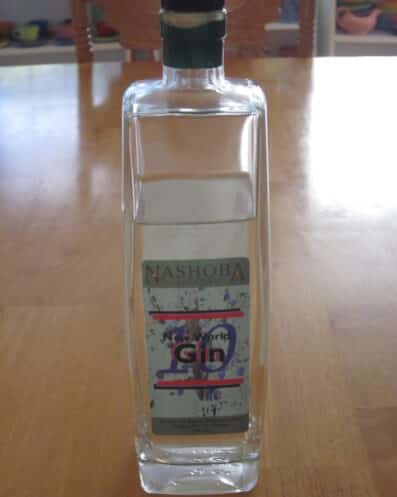Back in 2005, a Bolton, Massachusetts winery released a gin. Worthy of remark, especially today, because what we’re tasting is a gin which was first distilled before the Gin Renaissance really even took off. 2005 was post-Hendrick’s, post-Martin Miller’s. But 2005 was also a time of liquor stores with only a small handful of gins. It was a time before Bluecoat, Bulldog and many of the other elder statesmen of the Gin Renaissance.
In a time before the craft distilling lobby had pushed to change laws across the United States, Nashoba Valley Winery was Massachusetts first licensed Farmer Distillery, all the way back in 2003. A lot has changed since this time, but Nashoba’s ‘perfect 10’ gin (so called for the 10 botanicals) is still available. The restaurant at the distillery is mixing up French 75’s with Nashoba Perfect 10 Gin.
Tasting Notes
The nose immediately smells like apple pie spices. Lots of allspice, nutmeg and cinnamon. I can almost smell the apples beneath it. It’s so strongly suggestive of the aforementioned spice mixture, in a blind nosing I might immediately think I was about to sip an apple pie moonshine or something.
That being said, as the top notes lift, I start to get more anise and fennel with a note of clove oil. It’s really fascinating and incredibly vivid in its spice forward approach.
The palate again calls to mind fresh baked apple pie crust. At first I get a heavy hit of allspice at the front of the palate, mid-palate there’s a hint of juniper and anise, with a very heavy late palate hit of clove. The clove resonates loudly through the finish on the back of the throat. Exceptionally long and incredibly vivid long after the sip.
Cocktails
John recommended the Pink Gin in his review, and I similarly quite enjoyed it. I thought the Angostura bitters amplified the spice even further, but rounded out the palate. It was less literal pie spice and more like a melange. More like a spice store.
I found it to be a bit challenging and somewhat unusual in some of the standards. The Gin and Tonic tasted vaguely like their might be cloves in it. I found it to the refreshing character to be dissonant with the botanical profile, and the bitterness of the quinine amplifying the eugenol on the finish to an almost uncomfortable level. I prefer blending it with Vermouth, and found it to be good in a Martini, but perhaps even better in a Martinez. As for the latter, forgive that it’s not an Old Tom style gin and add a touch more simple syrup. It’s bright, spicy and really intriguing. Even today, I’m not sure there’s another gin quite like this on the market.
Overall
Fans of classic style juniper-forward gins may be put off by the incredible spice-forward approach. There’s barely any juniper in here. Nashoba Perfect 10 Gin was a true forerunner of the modern contemporary gin style. Those who’ve come to appreciate some of the spice-forward contemporary gins of the modern day may find the rare spice forward gin that doesn’t have the coriander amped up as part of the botanical mix to be intriguing, as well as a modern day comparable to 1495 Verbatim Gin.
Generally, I think Nashoba Perfect 10 is intriguing, if ultimately lacking in a bit of balance. A bit more juniper, or some botanicals mid-palate would tie the somewhat disjointed flavor together. Additionally, it’s somewhat odd and difficult for bartenders and home cocktail makers to use it as if a standard gin in most cocktails. Overall, it’s not just a historically interesting gin because of the time in which it was conceived. It’s an unusual gateway gin that will probably rapidly divide groups of tasters.
Thanks to….
Special thanks to John at Foodie Pilgrim. Since 2012, John has shared and sourced gins from New England and nearby that we at The Gin is In haven’t tried yet. This gin sample was shared by John, who is also a big fan of gin. So check out his New England Gin Reviews as well when you have a chance. Back in 2012 he also did a writeup on Nashoba Perfect 10 Gin.

